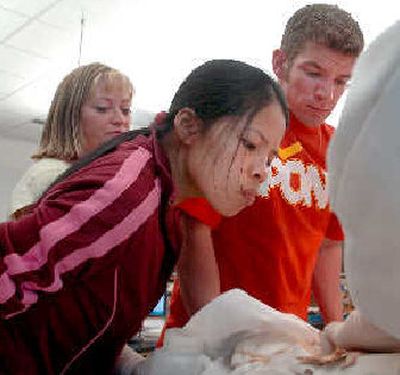NIC gets first cadaver

North Idaho College nursing student Matt Dingman read all the textbooks, studied all the computer programs, and dissected all the dead cats he was assigned.
But it wasn’t until he reached inside the body of a human that the would-be medical professional truly understood anatomy and physiology.
“I couldn’t get a better learning experience,” said Dingman, 31, gloved hands poised over the remains of the 90-year-old woman who has become NIC’s first classroom cadaver.
On Tuesday, Dingman conducted several blood vessel demonstrations for panels of fellow students trying to understand the workings of the circulatory system.
“This is our right coronary artery,” he said, sliding an instrument over the embalmed yellow-gray heart.
Six heads nodded at the latest in a series of lessons made possible by a rare arrangement between NIC and the Body Donation Program at Washington State University.
Last August, NIC became the only two-year college in the Northwest to have access to a cadaver, said Dr. Cheri Zao, an instructor and coordinator of the body donation program. She and her husband, Peter Zao, who heads the science program, persuaded officials to lend them one of the 15 to 20 bodies donated to WSU each year.
“Peter and Cheri called me and we talked quite a bit,” said Dr. David Conley, director of the program that is part of the Washington, Wyoming, Alaska, Montana and Idaho – WWAMI – medical education cooperative.
“They didn’t have the facilities in the past,” Conley said.
But NIC’s new $11.9 million Meyer Health and Sciences Building was a big draw. So was the reputation of the Zaos, who promised to uphold strict standards for security and educational relevance.
“Even though it’s loaned to North Idaho, (the cadaver) is still under our responsibility,” Conley said, noting that WSU will cremate and dispose of the woman’s remains.
But, for about the next four years, the body will be the protected property of NIC staff and a handful of advanced science students. Starting last fall, students were allowed to begin prosection, the clinical term for dissection of human cadavers.
So far, the body has been significantly dissected, with the abdominal cavity open, organs and muscles removed, arteries and veins exposed. Students learn from every fiber of the cadaver, Cheri Zao said, except for the face and hands, which remain covered out of respect for the dead.
“That’s personal,” she said. “We cover the face and hands because that’s how people personally identify. It helps to make it a little more clinical.”
Balancing the elements of individual identity with medical necessity is a delicate dance at every stage of body donation, organizers said.
No question, would-be doctors, nurses, dentists, pharmacists and others need access to cadavers from which to learn. Even animals and advanced computer programs can’t substitute for the reality of human flesh, Conley said.
“You want somebody trained who has actually experienced a dead person,” he said. “You cannot learn the layering of the body, you cannot learn the spatial orientation of things from a computer.”
But gaining access to bodies can be difficult. Medical schools and body donation programs are forbidden from buying bodies or using unclaimed bodies from a range of sources. All bodies must be willful donations, intentional contributions in the interest of medical or scientific advancement, Conley said.
Conley hears frequently from people who want to donate their bodies to the program. Some are people who had a significant medical experience in their lives. Some are husbands and wives who both donate their bodies. Some are people who wanted to make one final difference in the world.
Most, but not all, bodies are accepted, Conley said. Contagious or advanced disease, disfigurement, severe obesity or severe malnutrition could disqualify a body.
At any time, there are 40 to 50 bodies heavily embalmed and stored in a secure, but not refrigerated, room at WSU. They’re typically used by graduate medical students in the WWAMI program, Conley said.
The NIC arrangement is governed by the same standards used in the medical school programs. There’s a strict code that demands respect for the cadavers. Students aren’t allowed to nickname the bodies, for instance, and any horseplay can result in severe sanctions.
At NIC, students said they take their studies too seriously to contemplate either jokes – or jitters – about the body.
“I didn’t get really creeped out,” said Shannon Garcia, 21, a pre-nursing student who has observed prosections. “You don’t have an emotional attachment to the person. It’s not like you’re dissecting a family member.”
The more he works on the cadaver, the more she – it – becomes like a specimen, said Matt Dingman.
“It doesn’t feel human, but we still have the respect of a human,” he said.
That’s an important lesson for students to learn, noted Cheri Zao, who hopes to acquire a second cadaver next year.
“You have to divorce yourself on a certain level,” she said. “But still keep your humanitarian edge.”